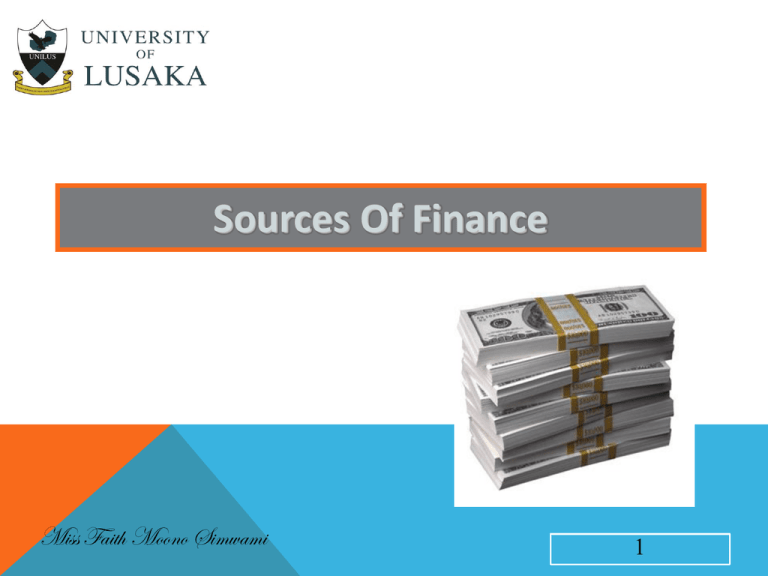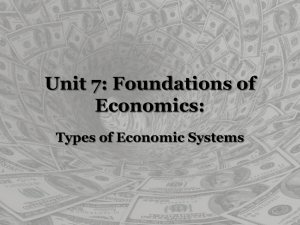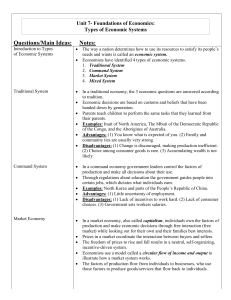Sources Of Finance
advertisement

Sources Of Finance
Miss Faith Moono Simwami
1
REVISION
7. What’s the difference between:
1.
What is a Financial Market?
- Commodity Market and Financial Market
2.
What is the primary role of a financial
intermediary?
- Direct and Indirect financing
3.
What is the function of the Financial
Market?
- Primary and Secondary Market
4.
List 4 different types of Financial
Markets.
8. Define:
5.
In what two distinct ways can a firm
or an individual obtain funds in a
financial market?
6.
What factors affect Security Expected
Returns?
- A bond and a stock
- Exchanges and Over the Counter Market
- Money markets
- Commercial Paper
- Capital markets
- Treasury Bills (T-bills)
-
Expected Return
9. Why is shareholder wealth maximization
important?
AFTER STUDYING SOURCES OF FINANCE, YOU SHOULD BE ABLE
TO:
Understand the different ways a business can obtain money
The External Sources of Finance
Bank Loan or Overdraft
Additional Partners
Share Issue
Leasing
Hire Purchase
Mortgage
Trade Credit
Government Grants
The Internal Sources of
Finance
Owner’s investment
Retained profits
Sale of stock
Sale of fixed assets
Debt collection
3
Almost half of all new ventures fail because
of poor financial management
4
SOURCES OF FINANCE
Sources of finance can be classified into
INTERNAL SOURCES
There are five internal sources of finance:
Owner’s investment (start up or additional capital)
Retained profits
Sale of stock
Sale of fixed assets
Debt collection
INTERNAL SOURCES:
OWNER’S INVESTMENT
This is money which comes
from the owner/s own savings
Advantages
It may be in the form of start
up capital - used when the
business is setting up
Doesn’t have to be repaid
No interest is payable
It may be in the form of
additional capital – perhaps
used for expansion
Disadvantages
There is a limit to the
amount an owner can invest
This is a long-term source of
finance
INTERNAL SOURCES:
RETAINED PROFITS
This source of finance is only
available for a business which
has been trading for more than
one year
Advantages
It is when the profits made
are ploughed back into the
business
Disadvantages
This is a medium or long-term
source of finance
Doesn’t have to be repaid
No interest is payable
Not available to a new
business
Business may not make
enough profit to plough back
INTERNAL SOURCES:
SALE OF STOCK
Advantages
This money comes in from
selling off unsold stock
This is a short-term source of
finance
Quick way of raising finance
By selling off stock it reduces
the costs associated with
holding them
Disadvantages
Business will have to take a
reduced price for the stock
INTERNAL SOURCES
SALE OF FIXED ASSETS
This money comes in from selling off
fixed assets, such as:
a piece of machinery that is no longer needed
Businesses do not always have
surplus fixed assets which they can
sell off
Advantages
Good way to raise finance from
an asset that is no longer needed
Disadvantages
There is also a limit to the number of
fixed assets a firm can sell off
Some businesses are unlikely
to have surplus assets to sell
This is a medium-term source of
finance
Can be a slow method of
raising finance
INTERNAL SOURCES:
DEBT COLLECTION
A debtor is someone who owes a
business money
Advantages
A business can raise finance by
collecting the money owed to them
(debts) from their debtors
No additional cost in getting
this finance, it is part of the
businesses’ normal operations
Not all businesses have debtors
i.e. those who deal only in cash
Disadvantages
This is a short-term source of
finance
There is a risk that debts
owed can go bad and not be
repaid
EXTERNAL SOURCES
Trade Credit
The External sources of
finance are:
Share Issue
Bank Loan or Overdraft
Government Grants
Additional Partners
Hire Purchase
Mortgage
Leasing
EXTERNAL SOURCES
BANK LOAN
Advantages
This is money borrowed at
an agreed rate of interest over
a set period of time
Set repayments are spread over
a period of time which is good for
budgeting
This is a medium or longterm source of finance
Disadvantages
Can be expensive due to
interest payments
Bank may require security on
the loan
EXTERNAL SOURCES:
BANK OVERDRAFT Advantages
This is where the business is
allowed to be overdrawn on its
account
This means they can still write
cheques, even if they do not
have enough money in the
account
This is a short-term source of
finance
This is a good way to cover the
period between money going out of
and coming into a business
If used in the short-term it is
usually cheaper than a bank loan
Disadvantages
Interest is repayable on the
amount overdrawn
Can be expensive if used over a
longer period of time
EXTERNAL SOURCES:
ADDITIONAL PARTNERS
This is sources of
finance suitable for
a partnership
business
The new partner/s
can contribute extra
capital
Advantages
Doesn’t have to be repaid
No interest is payable
Disadvantages
Diluting control of the
partnership
Profits will be split more
ways
EXTERNAL SOURCES:
SHARE ISSUE
This is sources of finance
suitable for a limited company
Advantages
Doesn’t have to be repaid
No interest is payable
Involves issuing more
shares
Disadvantages
This is a long-term source of
finance
Profits will be paid out as
dividends to more shareholders
Ownership of the company could
change hands
EXTERNAL SOURCES
LEASING
Advantages
This method allows a business to
obtain assets without the need to pay
a large lump sum up front
It is arranged through a finance
company
Leasing is like renting an asset
It involves making set repayments
This is a medium-term source of
finance
Businesses can have the use of up
to date equipment immediately
Payments are spread over a period
of time which is good for budgeting
Disadvantages
Can be expensive
The asset belongs to the finance
company
EXTERNAL SOURCES
HIRE PURCHASE
This method allows a business to
obtain assets without the need to pay a
large lump sum up front
Involves paying an initial deposit and
regular payments for a set period of time
The main difference between hire
purchase and leasing is that with hire
purchase after all repayments have been
made the business owns the asset
This is a medium-term source of
finance
Advantages
Businesses can have the use of
up to date equipment immediately
Payments are spread over a
period of time which is good for
budgeting
Once all repayments are made
the business will own the asset
Disadvantages
This is an expensive method
compared to buying with cash
EXTERNAL SOURCES:
MORTGAGE
This is a loan secured on
property
Repaid in instalments over a
period of time typically 25 years
The business will own the
property once the final payment
has been made
This is a long-term source of
finance
Advantages
Business has the use of the property
Payments are spread over a period
of time which is good for budgeting
Once all repayments are made the
business will own the asset
Disadvantages
This is an expensive method
compared to buying with cash
If business does not keep up with
repayments the property could be
repossessed
EXTERNAL SOURCES:
TRADE CREDIT
Trade credit is summed up
by the phrase:
buy now pay later
Typical trade credit period
is 30 days
This is a short-term source
of finance
Advantages
Business can sell the goods first and pay
for them later
Good for cash flow
No interest charged if money is paid
within agreed time
Disadvantages
Discount given for cash payment would
be lost
Businesses need to carefully manage
their cash flow to ensure they will have
money available when the debt is due to
be paid
EXTERNAL SOURCES:
GOVERNMENT GRANTS Advantages
Don’t have to be repaid
Government organisations
such as Invest NI offer grants
to businesses, both
established and new
Usually certain conditions
apply, such as where the
business has to locate
Disadvantages
Certain conditions may
apply e.g. location
Not all businesses may
be eligible for a grant
FACTORS AFFECTING CHOICE OF
SOURCE OF FINANCE
The source of finance chosen will depend on a number of factors:
Purpose – what the finance is to be used for
Time Period – how long the finance will be needed for
Amount – how much money the business needs
Ownership and Size of the business
CLARIFICATION
ASSIGNMENT
-Make sure the company you chose has at
least 3 years of financial data
-Use the Comprehensive Statements, not
the Consolidated
-Conduct Ratios on all THREE YEARS, as
this will enable you to evaluate the firm’s
performance over time
-Ensure that all statements are inserted
into Excel under different labelled
WorkSheets
HOMEWORK
-Stocks & Shares
-
Define the difference
Who are they sold to?
How are they sold?
When are they sold?
Then… what is the role of the stock
exchange?
-Listed Company
- What are the requirements needed
to become a listed company?
•
Marketable Securities
•
Cash & Cash Equivalents
•
Net Sales
•
Total Liabilities
•
Total Earning
•
Return on Assets
•
Interest Expense
•
Common Shares Outstanding
•
Average Inventory
•
Common Stakeholders
M A R K E TA B L E
SECURITIES
Very liquid securities that can be converted
into cash quickly at a reasonable price in
less than 1 year:
•commercial paper
•banker's acceptances
•Treasury bills and other money market
instruments
Investments in common stock, preferred
stock, corporate bonds, or government
bonds that can be readily sold on a stock
or bond exchange. These investments are
reported as a current asset if the investor's
intention is to sell the securities within one
year.
CASH & CASH
EQUIVALENT
CCE' An item on the balance sheet that
reports the value of a company's assets
that are cash or can be converted into
cash immediately.
Examples of cash and cash equivalents
are bank accounts, marketable securities
and Treasury bills.
TOTA L
LIABILITIES
The aggregate of all
debts an individual or
company is liable for. On
the balance sheet, total
liabilities plus equity must
equal total assets.
TOTA L E A R N I N G S
Total Earnings =
Total Income =
Gross Income =
Gross Profit
NET SALES
Net sales is total revenue, less the cost of sales returns, allowances, and
discounts. If the Income statement does not account for these deductions, for
the purpose of your assignments, just use the top Revenue/Sales figure.
For example:
If a company has gross sales of $1,000,000, sales returns of $10,000, sales
allowances of $5,000, and discounts of $15,000, then its net sales are calculated as
follows:
$1,000,000 Gross sales - $10,000 Sales returns - $5,000 Sales Allowances - $15,000
Discounts
= $970,000 Net sales
RETURN ON
ASSETS
Measures the company's ability to
utilize its assets to create profits
Beginning Total Assets –
Assets at previous year end
Ending Total Assets –
Assets at current year end
INTEREST
EXPENSE
Interest Coverage Ratio (Times Interest Earned)
Indicates a company's capacity to meet interest
payments. Uses EBIT (Earnings Before Interest
and Taxes)
Interest expense is a non-operating expense
shown on the income statement. It represents
interest payable on any type of borrowings –
bonds, loans, convertible debt or lines of credit. It
is basically calculated as the interest rate times
the outstanding principal amount of the debt.
COMMON
SHARES
O U T S TA N D I N G
Outstanding shares
are common stock
authorized by the
company, issued,
purchased and held by
investors.
AV E R AG E
INVENTORY
Definition of average
inventory: An average of
beginning and ending
inventory. Formula:
{Inventory (current period) +
Inventory (prior period)} ÷ 2




